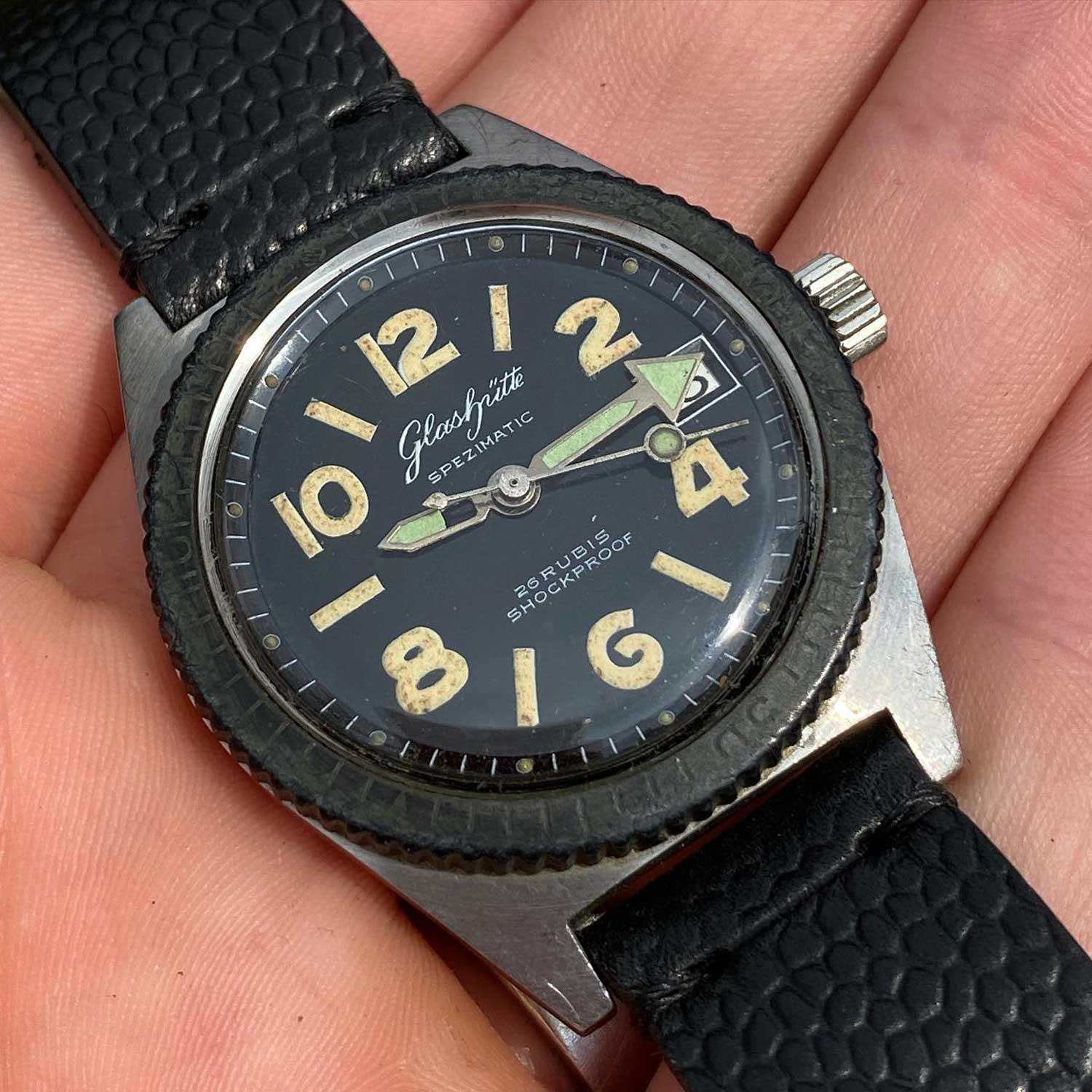Feature
Everything You Should Know About Glashütte Original’s Elevated Diver’s Chronograph
Everything You Should Know About Glashütte Original’s Elevated Diver’s Chronograph
Solid build, purposeful design, action-ready character: this is what makes a tool watch compelling and fun to wear. The likes of handcrafts and elegant movement engineering that distinguish the world’s most celebrated watchmakers? They demand a different type of appreciation entirely — and rarely the twixt shall meet.
In the tiny sliver where the Venn diagram of rugged tool and elevated horology intersects, however, is where sports watches seem to achieve their ultimate expression. And it’s this niche in which you’ll find Glashütte Original’s Spezialist collection and the SeaQ Chronograph. Offering refined details and high-end features at this level while remaining convincingly sporty and pragmatic is a balance few other watches achieve.
Even more than these qualities and the impressive balance thereof, the SeaQ Chronograph further embodies the brand’s history and spirit, as well as that of the Glashütte watchmaking region in Germany. Building on the first dive watch out of Glashütte from 1969, the SeaQ Chronograph brings the historically rooted design into resolutely contemporary territory.
The winding road to today’s Glashütte
To understand the SeaQ Chronograph’s character more precisely, it’s worth revisiting the fascinating and tumultuous saga of Germany’s watchmaking center and the emergence of Glashütte Original. The companies now in Glashütte have collectively risen to give the Saxon town a status on par with the most important watch manufacturing region in any country — and they inject welcome German personality into the otherwise Swiss- dominated watch industry.
The origin of the name Glashütte Original refers back to early movement inscriptions intended to reclaim traditional movement finishing and decoration emulated in other (even Swiss) watchmaking regions and termed “System Glashütte.” Such was the prestige of craftsmanship originating in the town. In response, the inscription “Original” was added to movements bearing the Glashütte designation, but the brand name is apt in more profound ways, as well: it recalls that the brand’s story itself is in many ways that of watchmaking in Glashütte.
The nearby Saxon capital of Dresden was already known for clockmaking and precision mechanics when the first watchmakers who would establish Glashütte’s industry prominence arrived around 1845. A century later, a robust if quiet industry had developed, but the town was all but demolished by a Soviet bombing raid just before World War II officially ended in 1945.
The brand Glashütte Original would eventually rise from those ashes, but first came hard times when the country was divided and the town of Glashütte found itself in East Germany under a socialist government and watchmaking machinery seized as part of war reparations. The seven major watchmaking companies in Glashütte were collectivized into the state-run GUB (VEB Glashütter Uhrenbetriebe) in 1951. Traditional mechanical movements continued to be produced here even through the Quartz Crisis that would later upend the wider industry.
After the reunification of Germany in 1990, a full- blown German watchmaking renaissance ensued over the following decades. Some of the historic brand names were resurrected but the GUB itself was also privatized. It was subsequently purchased by a private investor in 1994, renamed Glashütte Original and eventually acquired by the Swatch Group in the year 2000. Though its path is far from smooth or straight, the watchmaking that has culminated in the modern brand Glashütte Original has been continuous since the 19th century.
The first Glashütte dive watch
But let’s return for a moment to the days of the GUB. Forced to make essentially every component itself, the company produced robust movements such as the caliber 75 “Spezimatic.” Today’s collectors would excitedly call watchmaking such as this “in-house,” though such vertical integration was less common and less appreciated at the time than it is today. This was the automatic movement that found its way into the first dive watch out of Glashütte.
By the late 1960s, diving had evolved from its early days as an activity reserved for professionals into a growing leisure activity for amateurs. Watches were necessary diving tools at the time, but they’d also been gaining popularity and finding their way into the wider culture. The celebrated watchmakers in Glashütte hadn’t yet produced their own take on the segment, but GUB would change that.
In 1969, the GUB Spezimatic Type RP TS 200 was the first dive watch to come out of Glashütte. Robust and “shockproof,” as its dial declared, the 36mm watch was made not only for recreation but for military combat divers. Along with its German provenance and fascinating backstory, its arrow-shaped minute hand and oversized Arabic numerals would make it a rare but fascinating specimen for later watch collectors.
Glashütte Original resurrected the model 50 years later and with it inaugurated a sports watch line called the Spezialist. It began with the SeaQ dive watch and a faithful reissue of the Spezimatic Type RP TS 200 with modernized specs, but the collection soon began to evolve its own, more contemporary character. The SeaQ Panorama Date incorporated the typical Panorama Date display emblematic of Glashütte Original, and a chronograph soon followed.
The SEAQ Chronograph
Now 55 years after the first Glashütte dive watch comes a new variant of the SeaQ Chronograph. First introduced in 2022, it combined the Panorama Date complication with a flyback chronograph to result in a very new and contemporary look — though one remaining clearly rooted in its history. In contrast to the off-center placement of the large date display’s window at 4:30 (as found on the Panorama Date model), symmetry and design harmony took precedence with the date centered above six o’clock.
Joining the all-blue model of 2022 is a striking new variant in a silver-and-black, almost “panda dial,” colorway. It seems to bring the watch’s design elements further to the fore. Glashütte Original’s product designer explains, however, that the intent is more than aesthetic: “The color scheme as well as the shape of the indexes and hands are designed for maximum contrast to ensure perfect legibility in all light conditions, which is further enhanced by generously applied Super-LumiNova.”
Legibility and functionality are fundamental to any watch, and sports watches in particular. That’s not to say, however, that visual harmony isn’t also a consideration — the two often going hand-in-hand, anyway. The designer continues, “The SeaQ Chronograph’s two subdials create a calming symmetry that conveys a sense of precision and functionality. At the same time, the Glashütte Original Panorama Date perfectly resonates with the utilitarian design as well as the proportions of the lower half of the dial. The compact arrangement of the displays left the necessary space to maintain the characteristic numerals at six and 12 o’clock, which are typical of the SeaQ line and derived from its historic predecessors.”
Speaking of its historic predecessors, Glashütte Original further noted how “the SeaQ Chronograph is a fusion of our historically inspired diver’s watches from the Spezialist line and our technically sophisticated column-wheel chronograph caliber 37.” And this movement helps elevate the SeaQ Chronograph far above any notion of a mere tool watch. This is high-end watchmaking, and it reminds you of that every time you turn the watch over and see the movement shimmering through the caseback window.
It’s the caliber 37-23, to be specific, an integrated (rather than modular) chronograph with desirable features such as a column wheel, 70 hours of power reserve, and flyback functionality. The column wheel is valued by collectors for the smooth feedback it offers when activating the chronograph, and flyback functionality allows one to restart the chronograph without first stopping it — simple- sounding functionality but that which, in practice, levels up the already complex nature of a chronograph.
This movement is differentiated from other caliber 37 variants such as those found in the Senator and Vintage collection chronographs in a few ways. It’s comparatively simplified without the likes of a 12-hour chronograph counter or power reserve indicator, and it also boasts increased shock resistance. This all feels appropriate for the sporty nature of a diver chronograph.
Through the caseback, you’ll be able to even better appreciate the movement and many of the qualities that make Glashütte Original the symbol of prestigious German watchmaking that it is. The plates and automatic rotor are on display and decorated with Glashütte stripes. Geneva or other striping is a common finishing technique, but not all examples are executed equally and the clean precision and contrasting surfaces seen through the SeaQ’s caseback speak for themselves. Other elements will feature galvanized and polished finishes as well as beveled edges, and blued screws will add pops of color.
As with its GUB predecessor, nearly every component in a Glashütte Original watch is made in-house. The building once constructed for the GUB has been renovated to house Glashütte Original today where mills, lathes and other machinery churn out tools and parts on the first floor, while above is assembly and watchmaking, with finishing on the third floor.
The intensive testing a watch such as a diver’s chronograph requires is also done in-house. Tests include resistance to shock, salt-water corrosion, as well as water resistance and airtight-ness during pressure changes and in conditions such as high altitudes or, of course, underwater. It meets ISO 6425 and DIN 8306 specifications and a silicon hairspring helps ensure accuracy and magnetic resistance. Refined finishes and rugged features are not, however, limited to the movement. The same level of details and engineering makes the case of the SeaQ Chronograph itself feel holistic with its greater theme of refinement. The watch’s designer elaborates, “Polished satin-finished stainless steel cases with precise facets are used for accentuation. Domed sapphire crystals with anti-reflective coating on both sides visually reduce the height of the watch and simultaneously continue the typical look of the Spezialist collection.”
The bezel, a defining feature of dive watches, is also one that collectors tend to scrutinize for elements from its materials to its sound and feel. These, too, were carefully considered, along with its functionality: “The SeaQ Chronograph also features a unidirectional rotating bezel with scratch resistant ceramic inlay that provides excellent haptic and acoustic feedback. The Super-LumiNova filled triangle on the bezel can be precisely adjusted to the distinctive triangle at the tip of the minute hand, thus mastering this crucial function of a dive watch.”
As captivating as traditional watchmaking and classical German styles can be, sports watches are popular for good reason: they’re fun and promise durability. Glashütte Original is in the rare position to be able to leverage the know-how and reputation for both rugged tools and high watchmaking — and to combine them in a way that makes for the kind of product any fan of tool watches would pine for.
Tech Specs: Glashütte Original Spezialist SEAQ Chronograph
Movement: Self-winding caliber 37-23; 70-hour power reserve
Functions: Hours, minutes, small seconds, flyback chronograph and Panorama Date
Case: 43.2mm; stainless steel; water resistant to 300m
Dial: Silver and black; Super-LumiNova filled applied hour markers
Strap: Rubber, synthetic fabric or stainless steel bracelet
Price: USD 14,400 – USD 15,600
Learn more on Glashütte Originals website
Glashütte Original






















